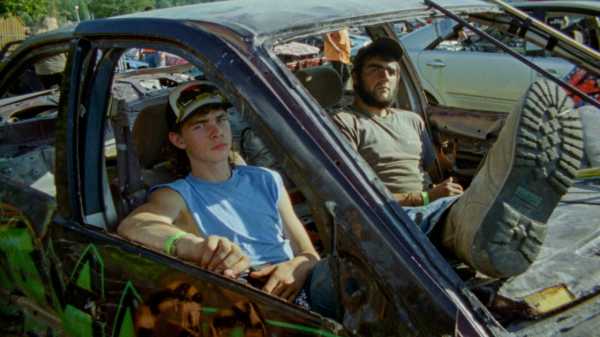
Save this storySave this storySave this storySave this story
Watch Alec Sutherland’s “Demolition.”
There is an uncanny shot toward the end of Alec Sutherland’s short film “Demolition” that is easy to miss. A demolition-derby driver, her hair matted with perspiration, her mangled car held together by chains, peers out of what would be her window, had there been any glass left. She enjoys a blissed-out sigh. In her left hand—and this is the jarring thing—she holds an iPhone; its lens points right at Sutherland’s. It’s the only overt incursion of the digital into a film that is so tangible, so physical, that it feels as though you could hold it in your hands.
The New Yorker Documentary
View the latest or submit your own film.

A demolition derby is basically what you’d imagine: you ram your car into other cars, until only one car is left running. The appeal is, it’s fun to smash stuff into other stuff. One driver tells Sutherland that his motivation is not money or anything like that; it’s to “make junk.” Is there a better reminder, in our increasingly digitized lives, that there’s a world out there of atoms and metals, bodies and tendons, and that these things sometimes batter, crumple, and explode? The director, who has a home in Delaware County, in upstate New York, spent the summer of 2022 going to derbies at local fairs. His short includes portraits of the derby scene’s characters: a man who goes by Cooter whose vehicles are declared “Cooter Built”; a man who races wearing a shirt and tie. Sutherland shot the film on a Bolex 16-mm. spring-driven camera—“the only camera I own,” he told me. The camera is wound by a hand crank, which affords a nearly thirty-second run time. “I can’t tell you how many times I had to explain to people what I was holding,” he said. The film pops and crackles as the cars mangle and the drivers embrace and fight.
Sutherland worked on the project alone. “I was able to kind of be invisible in a lot of ways,” he told me. He got close enough to capture fights, blood, and fires. “Demolition” describes tragic deaths and family drama. The young drivers, in particular, are part of a generation with soaring rates of anxiety and depression. Phones and social media, of course, bear a lot of the responsibility. But along with the violence of the derby there is also a surprising tenderness. There are lots of hugs. One bearded, bare-sleeved tough guy ties balloons onto someone’s car for a birthday. Derbies are a coming together, in more ways than one.
Two participants who appeared in the film, Sutherland told me, were a mother-and-son pair. Linda Fisher, the mother, opened up to him about the recent death of her husband. Korey, her son, remained emotionally guarded. The filmmaker once watched them at a derby when they ended up in the same early heat. “He basically defended his mother out on this demolition course,” Sutherland said. “They both drove like crazy, and they got to the end and both of their cars were still running. As soon as the horn went, I saw Korey bolt out of the car, run across the track, and hug his mother.” The Fishers are a derby legacy family: father, mother, and sons. Linda’s other son, Jacob, also competes. He’s the driver who said that he likes to “make junk.” He and Korey had fallen out at the time. “They weren’t even speaking anymore,” Sutherland said. “But they smashed each other.”
Sourse: newyorker.com